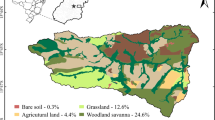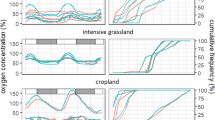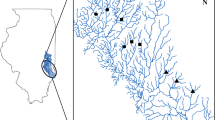Abstract
Watershed land cover affects in-stream water quality and sediment nutrient dynamics. The presence of natural land cover in the riparian zone can reduce the negative effects of agricultural land use on water quality; however, literature evaluating the effects of natural riparian land cover on stream sediment nutrient dynamics is scarce. The objective of this study was to assess if stream sediment phosphorus retention and nitrogen removal varies with riparian forest cover in agricultural watersheds. Stream sediment nutrient dynamics from 28 sites with mixed land cover were sampled three times during the growing season. Phosphorus dynamics and nitrification rates did not change considerably throughout the study period. Sediment total phosphorus concentrations and nitrification rates decreased as riparian forest cover increased likely due to a decline in fine, organic material. Denitrification rates were strongly correlated to surface water nitrate concentrations. Denitrification rate and denitrification enzyme activity decreased with an increase in forest cover during the first sampling period only. The first sampling period coincided with the greatest connectivity between the watershed and in-stream processing, indicating that riparian forest cover indirectly decreased denitrification rates by reducing the concentrations of dissolved nutrients entering the stream. This reduction in load may allow the sediment to maintain greater nitrogen removal efficiency, because bacteria are not saturated with nitrogen. Riparian forest cover also appeared to lessen the effect of agriculture in the watershed by decreasing the amount of fine material in the stream, resulting in reduced phosphorus storage in the stream sediment.





Similar content being viewed by others
References
Allan JD (2004) Landscapes and riverscapes: the influence of land use on stream ecosystems. Annu Rev Ecol Evol Syst 35:257–284
Ammann A, Stone AL (1991) Method for the comparative evaluation of nontidal wetlands in New Hampshire. NHDES-WRD-1991-3. New Hampshire Department of Environmental Services, Concord, NH
(2017) Standard methods for the analysis of water and wastewater. 23rd ed. American Public Health Association, Washington DC
Arango CP, Tank JL (2008) Land use influences the spatiotemporal controls on nitrification and denitrification in headwater streams. J North Am Benthol Soc 27:90–107
Barton K (2019) Package ‘MuMIn’, R package version 1.43.6, https://CRAN.R-project.org/package=MuMIn
Boyer EW, Alexander RB, Parton WJ, Li C, Butterbach-Bahl K, Donner SD, Skaggs RW, Del Grosso SJ (2006) Modeling denitrification in terrestrial and aquatic ecosystems at regional scales. Ecol Appl 16:2123–2142
Cherry KA, Shepherd M, Withers PJA, Mooney SJ (2008) Assessing the effectiveness of actions to mitigate nutrient loss from agriculture: a review of methods. Sci Total Environ 406:1–23
Christensen VG, Kieta KA (2014) Assessment of conservation easements, total phosphorus, and total suspended solids in West Fork Beaver Creek, Minnesota, 1999-2012. US Geological Survey Scientific Investigation Report 2014-5002, https://doi.org/10.3133/sir20145002
Christensen VG, Lee KE, McLees JM, Niemela SL (2012) Relations between retired agricultural land, water quality, and aquatic-community health, Minnesota River Basin. J Environ Qual 41:1459–1472
Covino T (2017) Hydrologic connectivity as a framework for understanding biogeochemical flux through watersheds and along fluvial networks. Geomorphology 277:133–144
Czuba JA, Hansen AT, Foufoula-Georgiou, Finlay JC (2018) Contextualizing wetlands within a river network to assess nitrate removal and inform watershed management. Water Resour Res 54:1312–1337
De’ath G, Fabricius KE (2000) Classification and regression trees: a powerful yet simple technique for ecological data analysis. Ecology 81:3178–3192
Duff JH, Tesoriero AJ, Richardson WB, Strauss EA, Munn MD (2008) Whole-stream response to nitrate loading in three streams draining agricultural landscapes. J Environ Qual 37:1133–1144
Durner W, Iden SC, von Unold G (2017) The integral suspension pressure method (ISP) for precise particle-size analysis by gravitational sedimentation. Water Resour Res 53:33–48
Froelich PN (1988) Kinetic control of dissolved phosphate in natural rivers and estuaries: a primer on the phosphate buffer mechanism. Limnol Oceanogr 33:649–668
Gregory SV, Swanson FJ, McKee WA, Cummins KW (1991) An ecosystem perspective of riparian zones. Bioscience 41:540–551
Groffman PM, Holland EA, Myrold DD, Robertson GP, Zhou X (1999) Denitrification. In: Robertson GP, Coleman DC, Bledsoe CS, Sollins P (Eds.) Standard soil methods for long-term ecological research. Oxford University Press, New York, NY, p 272–288
Haggard BE, Scott JD, Longing SD (2013) Sestonic chloropyll-a shows hierarchical structure and thresholds with nutrients across the Red River Basin, USA. J Environ Qual 42:437–445
Hamilton SK(2012) Biogeochemical time lags may delay responses of streams to ecological restoration Freshw Biol 57(1):43–57
Hansen AT, Dolph CL, Finlay JC (2016) Do wetlands enhance downstream denitrification in agricultural landscapes? Ecosphere 7(10):e01516
Hansen AT, Dolph CL, Foufoula-Georgiou E, Finlay JC (2018) Contribution of wetlands to nitrate removal at the watershed scale. Nat Geosci 11:127–132
Hoffman CC, Kjaergaard C, Uusi-Kamppa J, Hansen HCB, Kronvang B (2009) Phosphorus retention in riparian buffers: review of their efficiency. J Environ Qual 38:1942–1955
Homer CG, Dewitz JA, Yang L, Jin S, Danielson P, Xian G, Coulson J, Herold ND, Wickham JD, Megown K (2015) Completion of the 2011 national land cover database for the conterminous United States – representing a decade of land cover change information. Photogramm Eng Rem S 77:758–762
Howarth R, Swanye D, Billen G, Garnier J, Hong B, Humborg C, Johnes P, Morth C-M, Marino R (2012) Nitrogen fluxes from the landscape are controlled by net anthropogenic nitrogen inputs and by climate. Front Ecol Environ 10:37–43
ISO (International Organization for Standardization) (2012). Soil quality - determination of potential nitrification and inhibition of nitrification - rapid test by ammonium oxidation. ISO 15685:2012(E). Geneva, Switzerland
James WF (2017) Internal phosphorus loading contributions from deposited and resuspended sediment to the Lake of the Woods. Lake Reserv Manag 33:347–359
Kaushal SS, Mayer PM, Vidon PG, Smith RM, Pennino MJ, Newcomer TA, Duan S, Welty C, Belt KT (2014) Land use and climate variability amplify carbon, nutrient, and contaminant pulses: a review with management implications. J Am Water Resour 50:585–614
Kautza A, Sullivan SMP (2015) Shifts in reciprocal river-riparian arthropod fluxes along an urban-rural landscape gradient. Freshw Biol 60:2156–2156
King RS, Baker ME, Whigham DF, Weller DE, Jordan TE, Kazyak PF, Hurd MK (2005) Spatial considerations for linking watershed land cover to ecological indicators in streams. Ecol Appl 15:137–153
Kreiling RM, Bartsch LA, Perner PM (2021) Great lakes restoration initiative fox River Basin 2018 Data: U.S. Geological Survey data release, https://doi.org/10.5066/P9PAS8DP
Kreiling RM, Houser JN (2016) Long-term decreases in phosphorus and suspended solids but not nitrogen, in six upper Mississippi River tributaries, 1991-2014. Environ Monit Assess 188:1–19
Kreiling RM, Richardson WB, Bartsch LA, Thoms MC, Christensen VG (2019a) Denitrification in the river network of a mixed land use watershed: unpacking the complexities. Biogeochemistry 143:327–346
Kreiling RM, Schubauer-Berigan JP, Richardson WB, Bartsch LA, Hughes PE, Cavanaugh JC, Strauss EA (2013) Wetland management reduces sediment and nutrient loading to the upper Mississippi River. J Environ Qual 42:573–583
Kreiling RM, Thoms MC, Bartsch LA, Richardson WB, Christensen VG (2019b) Complex response of sediment phosphorus to land use and management within a river network. JGR Biogeosci 124:1764–1780
Kreiling RM, Thoms MC, Richardson WB (2018) Beyond the edge: linking agricultural landscapes, stream networks, and best management practices. J Environ Qual 47:42–53
Lind L, Hasselquist EM, Laudon H (2019) Towards ecologically functional riparian zones: a meta-analysis to develop guidelines for protecting ecosystem functions and biodiversity in agricultural landscapes. J Environ Manag 249:109391
Lovell ST, Sullivan WC (2006) Environmental benefits of conservation buffers in the United States: evidence, promise, and open questions. Agric Ecosyst Environ 112:249–260
Lucci GM, McDowell RW, Condron LM (2010) Evaluation of base solutions to determine equilibrium phosphorus concentrations (EPC0) in stream sediments. Int Agrophys 24:157–163
Mayer PM, Reynolds Jr SK, McCutchen MD, Canfield TJ (2007) Meta-analysis of nitrogen removal in riparian buffers. J Environ Qual 36:1172–1180
McDaniel MD, David MB, Royer TV (2009) Relationships between benthic sediments and water column phosphorus in Illinois streams. J Environ Qual 38:607–617
McDowell RW, Sharpley AN, Folmar G (2003) Modification of phosphorus export from an eastern USA catchment by fluvial sediment and phosphorus inputs. Agric Ecosyst Environ 99:187–199
Meals DW, Dressing SA, Davenport TE (2010) Lag time in water quality response to best management practices-a review. J Environ Qual 39:85–96
Mehlich A (1984) Mehlich 3 soil test extractant: a modification of Mehlich 2 extractant. Comm Soil Sci Plant Anal 15:1409–1416
Michalak AM, Anderson EJ, Beletsky D, Boland S, Bosch NS, Bridgeman TB, Chaffin JD, Cho K, Confesor R, Daloglu I, Depinto JV, Evans MA, Fahnenstiel GL, He L, Ho JC, Jenkins L, Johengen TH, Kuo KC, LaPorte E, Liu X, McWilliams MR, Moore MR, Posselt DJ, Richards RP, Scavia D, Steiner AL, Verhamme E, Wright DM, Zagorski MA (2013) Record-setting algal bloom in Lake Erie caused by agricultural and meteorological trends consistent with expected future conditions. Proc Natl Acad Sci USA 110:6448–6452
Mulholland PJ, Helton AM, Poole GC, Hall Jr RO, Hamilton SK, Peterson BJ, Tank JL, Ashkenas LR, Cooper LW, Dahm CN, Dodds WK, Findlay SEG, Gregory SV, Grimm NB, Johnson SL, McDowell WH, Meyer JL, Valett HM, Webster JR, Arango CP, Beaulieu JJ, Bernot MJ, Burgin AJ, Crenshaw CL, Johnson LT, Niederlehner BR, O’Brien JM, Potter JD, Shiebley RB, Sobota DJ, Thomas SM (2008) Stream denitrification across biomes and its response to anthropogenic nitrate loading. Nature 452:202–205
Nair VD (2014) Soil phosphorus saturation ratio for risk assessment in land use systems. Front Environ Sci 2:6
Palmer-Felgate EJ, Jarvie HP, Withers PJA, Mortimer RJG, Krom MD (2009) Stream-bed phosphorus in paired catchments with different agricultural land use intensity. Agric Ecosyst Environ 134:53–66
Pant HK, Reddy KR (2001) Phosphorus sorption characteristics of estuarine sediments under different redox conditions. J Environ Qual 30:1474–1480
Pina-Ochoa E, Alvarez-Cobelas M (2006) Denitrification in aquatic environments: a cross-system analysis. Biogeochemistry 81:111–130
Pinheiro J, Bates D, DebRoy S, Sarkar D, EISPACK authors, Heisterkamp S, Van Willigen B, Ranke J (2021) Linear and nonlinear mixed effects models, R package version 3.1-152. https://svn.r-project.org/R-packages/trunk/nlme/
Qian SS (2017) Environmental and Ecological Statistics with R. CRC Press, Boca Raton, FL
Ranalli AJ, Macalady DL (2010) The importance of the riparian zone and in-stream processes in nitrate attenuation in undisturbed and agricultural watersheds - a review of the scientific literature. J Hydrol 389:406–415
R Core Team (2020) R: a language and environment for statistical computing. R Foundation for Statistical Computing, Vienna, Austria, https://www.R-project.org/
Records RM, Wohl E, Arabi M (2016) Phosphorus in the river corridor. Earth Sci Rev 158:65–88
Reddy KR, Kadlec RH, Flaig E, Gale PM (1999) Phosphorus retention in streams and wetlands: a review. Crit Rev Environ Sci Tech 29:83–146
Reisinger AJ, Tank JL, Hollein TJ, Hall Jr RO (2016) Sediment, water column, and open-channel denitrification in rivers measured using membrane-inlet mass spectrometry. J Geophys Res Biogeosci 121:1258–1274
Revilla M, Alexander J, Gilbert PM (2005) Urea analysis in coastal waters: comparison of enzymatic and direct methods. Limnol Oceanogr Methods 3:290–299
Richardson WB, Strauss EA, Bartsch LA, Monroe EM, Cavanaugh JC, Vingum L, Soballe DM (2004) Denitrification in the upper Mississippi River: rates, controls and contribution to nitrate flux. Can J Fish Aquat Sci 61:1102–1112
Seitzinger S, Harrison JA, Bohlke JK, Bouwman AF, Lowrance R, Peterson B, Tobias C, Van Drecht G (2006) Denitrification across landscapes and waterscapes: a synthesis. Ecol Appl 16:2064–2090
Sharpley A, Jarvie HP, Buda A, May L, Spears B, Kleinman P (2013) Phosphorus legacy: overcoming the effects of past management practices to mitigate future water quality impairment. J Environ Qual 42:1308–1326
Sheibley RW, Jackman AP, Duff JH, Triska FJ (2003) Numerical modeling of coupled nitrification-denitrification in sediment perfusion cores from the hyporheic zone of the Shingobee River, MN. Adv Water Res 26:977–987
Sims JT, Maguire RO, Leytem AB, Gartley KL, Pautler MC (2002) Evaluation of Mehlich 3 as an agri-environmental soil phosphorus test for the Mid-Atlantic United States of America. Soil Sci Soc Am J 66:2016–2032
Stoddard JL, Van Sickle J, Herlihy AT, Brahney J, Paulsen S, Peck DV, Mitchell R, Pollard AI (2016) Continental-scale increase in lake and stream phosphorus: are oligotrophic systems disappearing in the United States? Environ Sci Technol 50:3409–3415
Stow CA, Cha Y, Johnson LT, Confesor R, Richards RP (2015) Long-term and seasonal trend decomposition of Maumee River nutrient inputs to Western Lake Erie. Environ Sci Tech 49:3392–3400
Strauss EA, Mitchell NL, Lamberti GA (2002) Factors regulating nitrification in aquatic sediments: effects of organic carbon, nitrogen availability, and pH. Can J Fish Aquat Sci 59:554–563
Strauss EA, Richardson WB, Bartsch LA, Cavanaugh JC, Brusewitz DA, Imker H, Heinz JA, Soballe DM (2004) Nitrification in the upper Mississippi River: patterns, controls, and contribution to the nitrate budget. J North Am Benthol Soc 23:1–14
Sturt MM, Jansen MAK, Harrison SSC (2011) Invertebrate grazing and riparian shade as controllers of nuisance algae in a eutrophic river. Freshw Biol 56:2580–2593
Stutter MI, Lumsdon DG (2008) Interactions of land use and dynamic river conditions on sorption equilibria between benthic sediments and river soluble reactive phosphorus concentrations. Water Res 42:4249–4260
Therneau T, Atkinson B, Ripley B (2019) Recursive partitioning and regression trees, R package version 4.1-15, https://cran.r-project.org/package=rpart
Tomer MD, Sadler EJ, Lizotte RE, Bryant RB, Potter TL, Moore MT, Veith TL, Baffaut C, Locke MA, Walbridge MR (2014) A decade of conservation effects assessment research by the USDA Agricultural Research Service: progress overview and future outlook. J Soil Water Conserv 69:365–373
Valett HM, Thomas SA, Mulholland PJ, Webster JR, Dahm CN, Fellows CS, Crenshaw CL, Peterson CG (2008) Endogenous and exogenous control of ecosystem function: N cycling in headwater streams. Ecology 89:3515–3527
Van Meter KJ, Van Cappellen P, Basu NB (2018) Legacy nitrogen may prevent achievement of water quality goals in the Gulf of Mexico. Science 360:427–430
Vidon P, Allan C, Burns D, Duval TP, Gurwick N, Inamdar S, Lowrance R, Okay J, Scott D, Sebestyen S (2010) Hot spots and hot moments in riparian zones: potential for improved water quality management. J Am Water Resour 46:278–298
White MJ, Storm DE, Mittelstet A, Busteed PR, Haggard BE, Rossi C (2014) Development and testing of an in-stream phosphorus cycling model for the soil and water assessment tool. J Environ Qual 43:215–223
Williamson TN, Christensen VG, Richardson WB, Frey JW, Gellis AC, Kieta KA, Fitzpatrick FA (2014) Stream sediment sources in Midwest agricultural basins with land retirement along channel. J Environ Qual 43:1627–1634
Withers PJA, Jarvie HP (2008) Delivery and cycling of phosphorus in rivers: a review. Sci Total Environ 400:379–395
Wohl E (2015) Legacy effects on sediments in river corridors. Earth-Sci Rev 147:30–53
Wollheim WM, Bernal S, Burns DA, Czuba JA, Driscoll CT, Hansen AT, Hensley RT, Hosen JD, Inamdar S, Kaushal SS, Koenig LE, Lu YH, Marzadri A, Raymond PA, Scott D, Stewart RJ, Vidon PG, Wohl E (2018) River network saturation concept: factors influencing the balance of biogeochemical supply and demand of river networks. Biogeochemistry 141:503–521
Zhang X, Liu X, Zhang M, Dahlgren RA, Eitzel M (2010) A review of vegetated buffers and a meta-analysis of their mitigation efficacy in reducing nonpoint source pollution. J Environ Qual 39:76–84
Zuur AF, Ieno EN, Elphick CS (2010) A protocol for data exploration to avoid common statistical problems. Methods Ecol Evol 1:3–14
Zuur AF, Ieno EN, Walker NJ, Saveliev AA, Smith GM (2009) Mixed effects modelling for nested data. In Mixed effects models with extension in ecology with R, Springer, New York, pp. 101–142
Acknowledgements
We thank Alexandra Guenther, Cassandra Baranczyk, Paxton Smith, Steve Houdek, Devyn Edge, and Kenna Breckner for help with sample collection and analysis. We thank Shirley Yuan, John Manier, and Derek Craig for analyzing the water column nutrient samples and the U.S. Geological Survey (USGS) Upper Midwest Environmental Sciences Center GIS laboratory for GIS support. An earlier version of this manuscript was greatly improved by the reviews of Dr. Tanja Williamson, Dr. Jason Taylor, and three anonymous reviewers. This research was funded through the Great Lakes Restoration Initiative and the USGS Fisheries and Environments Programs. Raw data are available in USGS ScienceBase (10.5066/P9PAS8DP). Any use of trade, firm, or product names is for descriptive purposes only and does not imply endorsement by the U.S. Government.
Author information
Authors and Affiliations
Corresponding author
Ethics declarations
Conflict of Interest
The authors declare no competing interests.
Additional information
Publisher’s note Springer Nature remains neutral with regard to jurisdictional claims in published maps and institutional affiliations.
Supplementary information
Rights and permissions
About this article
Cite this article
Kreiling, R.M., Bartsch, L.A., Perner, P.M. et al. Riparian Forest Cover Modulates Phosphorus Storage and Nitrogen Cycling in Agricultural Stream Sediments. Environmental Management 68, 279–293 (2021). https://doi.org/10.1007/s00267-021-01484-9
Received:
Accepted:
Published:
Issue Date:
DOI: https://doi.org/10.1007/s00267-021-01484-9




